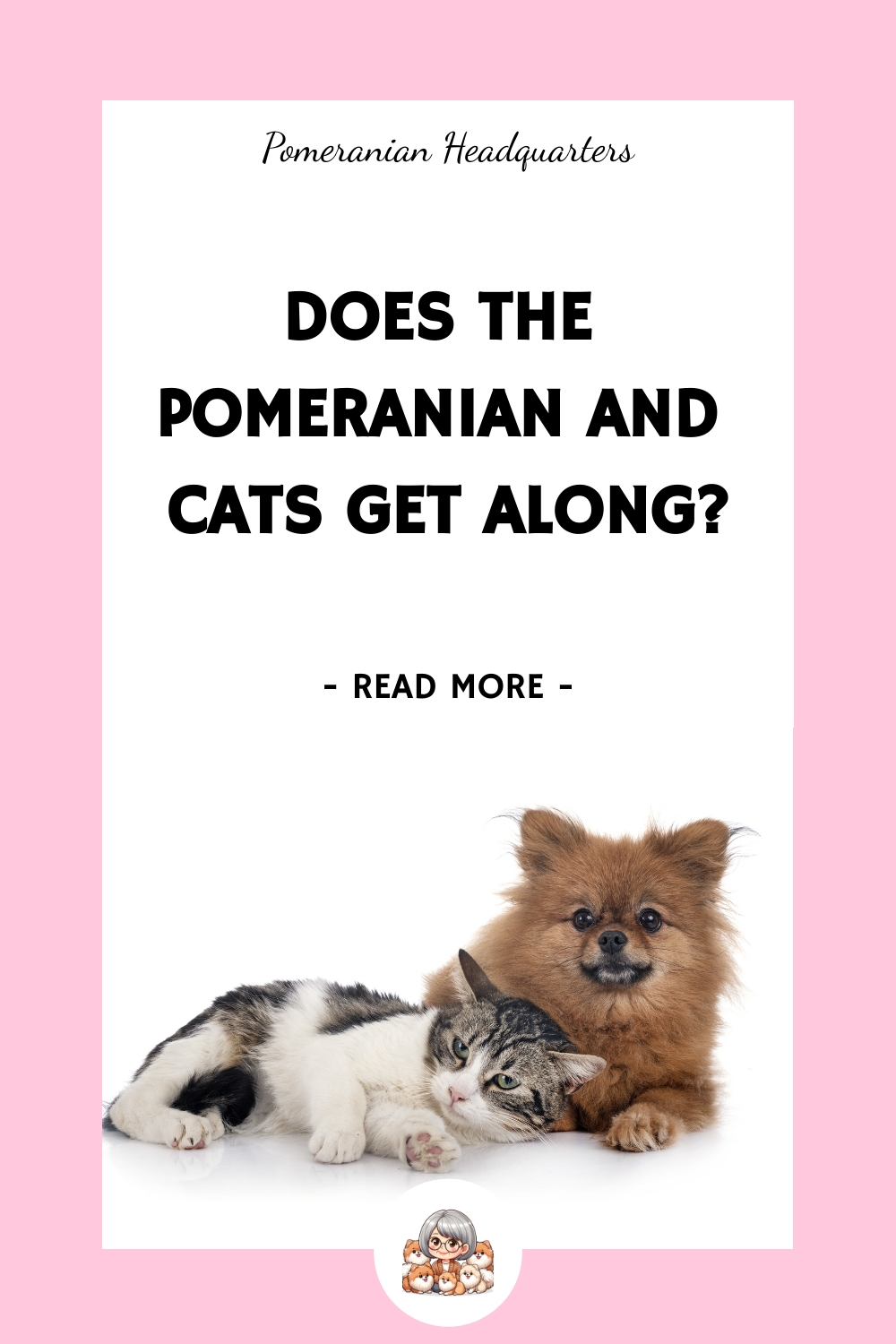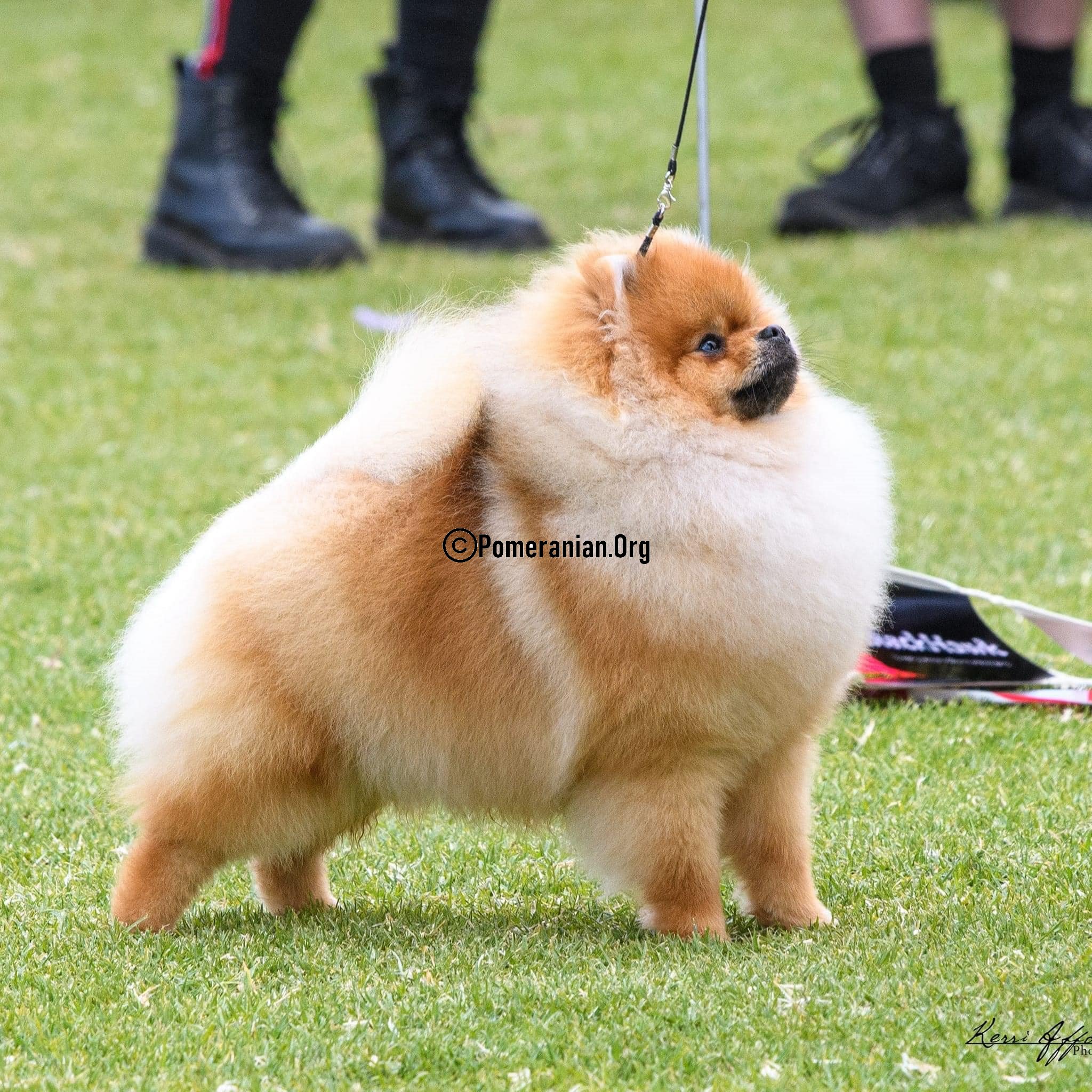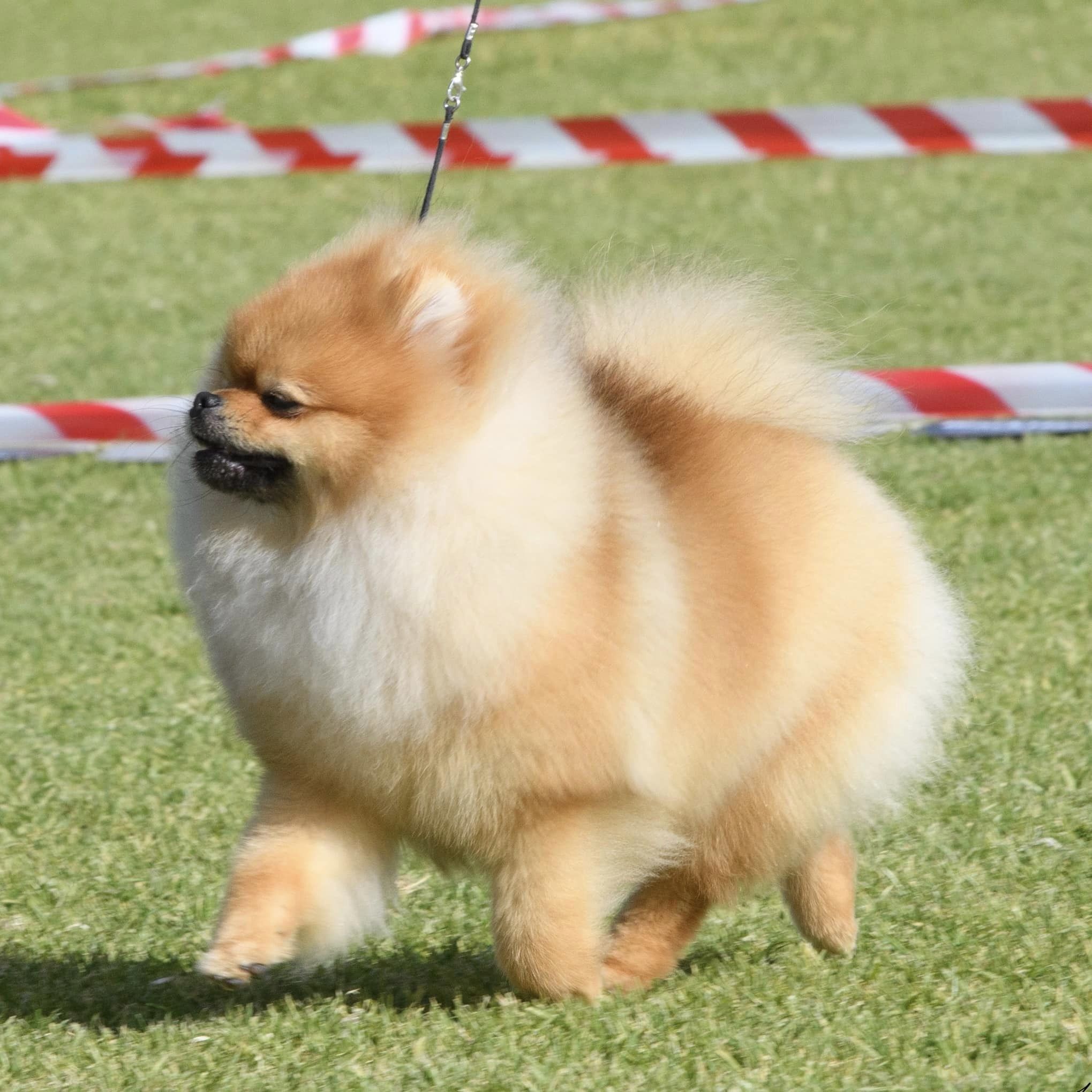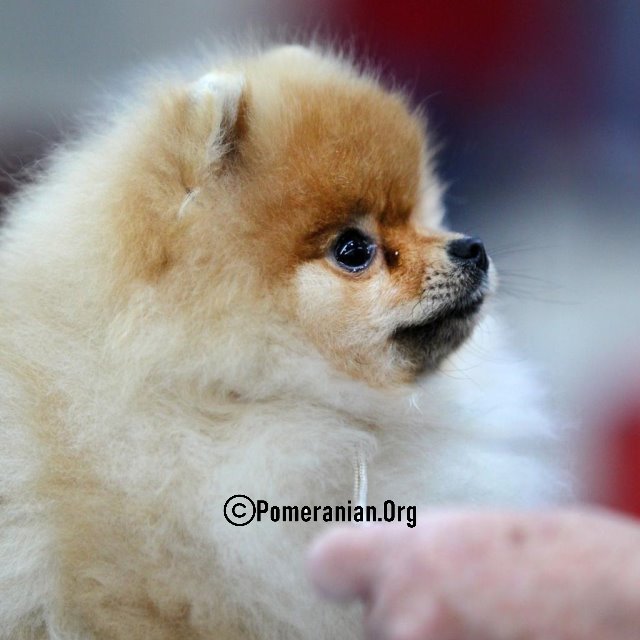Last Updated on 24/04/2024 by Denise Leo. Post first published on March 2, 2018.
Are Pomeranians good with cats? If you own both a Pomeranian and Cats, the size of these animals is good because both will be similar, and one major benefit is that your two pets, although different, will usually become good friends. An average cat will weigh approx. 8 – 12 lbs. If you want a canine and a feline living under your roof, there are certain guidelines to remember.
Strategies for Pomeranian and Cats Households
Introducing Pomeranians and cats into the same household can be a delightful experience, offering endless entertainment and companionship. However, creating a harmonious environment where these two species coexist peacefully requires understanding and patience.
This blog post explores the dynamics between Pomeranians and cats, providing tips for successful integration and ensuring a happy, stress-free home for both pets.
With their lively and affectionate nature, Pomeranians can make great companions for cats, especially if both animals are introduced to each other at a young age. Early socialization is key to helping Pomeranians and cats understand each other’s body language and boundaries.
When introducing a Pomeranian to a cat, it’s important to supervise their interactions closely. Look for signs of stress or aggression and separate them if necessary. Over time, most Pomeranians and cats can learn to coexist peacefully, often forming strong bonds.
Creating a safe space for both your Pomeranian and cat is essential. Ensure that each pet has its own retreat where it can relax without being disturbed. This is especially important for cats, who may seek high perches or secluded areas to observe their surroundings safely. Additionally, engaging in regular play sessions with your Pomeranian and providing interactive toys for your cat can help reduce potential jealousy and promote a positive relationship.
Feeding time can often be a source of tension between Pomeranians and cats. To prevent any food aggression, feed them separately and simultaneously. This approach avoids competition over food and helps establish a routine that both pets can rely on.
In conclusion, while the mix of Pomeranians and cats in one household might seem challenging, it is achievable with the right approach. Pet owners can create a loving and inclusive home environment by understanding Pomeranians’ and cats’ unique needs and behaviors.
Remember, patience and gradual introduction are your best tools in fostering a friendship between your Pomeranian and cat, leading to a harmonious and joyful living situation for everyone involved.

Pomeranian Dog Guidelines
If your dog constantly barks at cats and demonstrates a strong intolerance for them, then it wouldn’t be wise actually to bring a cat home. However, they’re positive signs if your dog is indifferent or curious about this different creature.
The next element is your confidence that you can use commands to control your dog, and he’ll obey. If there are times when he’s tense or you must step in and make him obey, the typical commands, including heel, come, stay, down, and sit, will be powerful tools in your arsenal.
It’s vital that you spend a lot of time training him to respond to your commands, but generally, you will reach that point. The last task is to ask a neighbor (who is a cat owner) if you can take your dog to visit him. This will test whether he has had sufficient training to obey you despite having a cat in the same room as a distraction.
Tactics for Cat Owners
Bringing a kitten or young cat into a Pomeranian household is always best. The kitten will quickly bond with other household pets and become the best buddy to your Pomeranian.
If you want to adopt an older cat who is currently living in a shelter, you must get as much information about him as possible. Has he spent any time living in a home with dogs? Before you commit, let the cat smell a blanket or small pillow belonging to your dog(s). These items contain scents for long periods of time. If the cat dislikes the odors, that may be the final test for that cat.
You’ll find that cats may hiss if they smell the dog’s scent, and that’s definitely a red flag. When you introduce two pets, you’re ideally looking for indifference.

Introducing Your Pomeranian and Cat
You can make the initial meeting go more smoothly if you have done everything mentioned here. However, any first meeting can be easy or difficult, and you can’t guess what may happen, so certain precautions should be taken.
Both animals must have their owner present to supervise and to take direct action if warranted. You may need to do this a few times, depending on how good or bad that first interaction went, and only stop once you believe there won’t be any more issues.
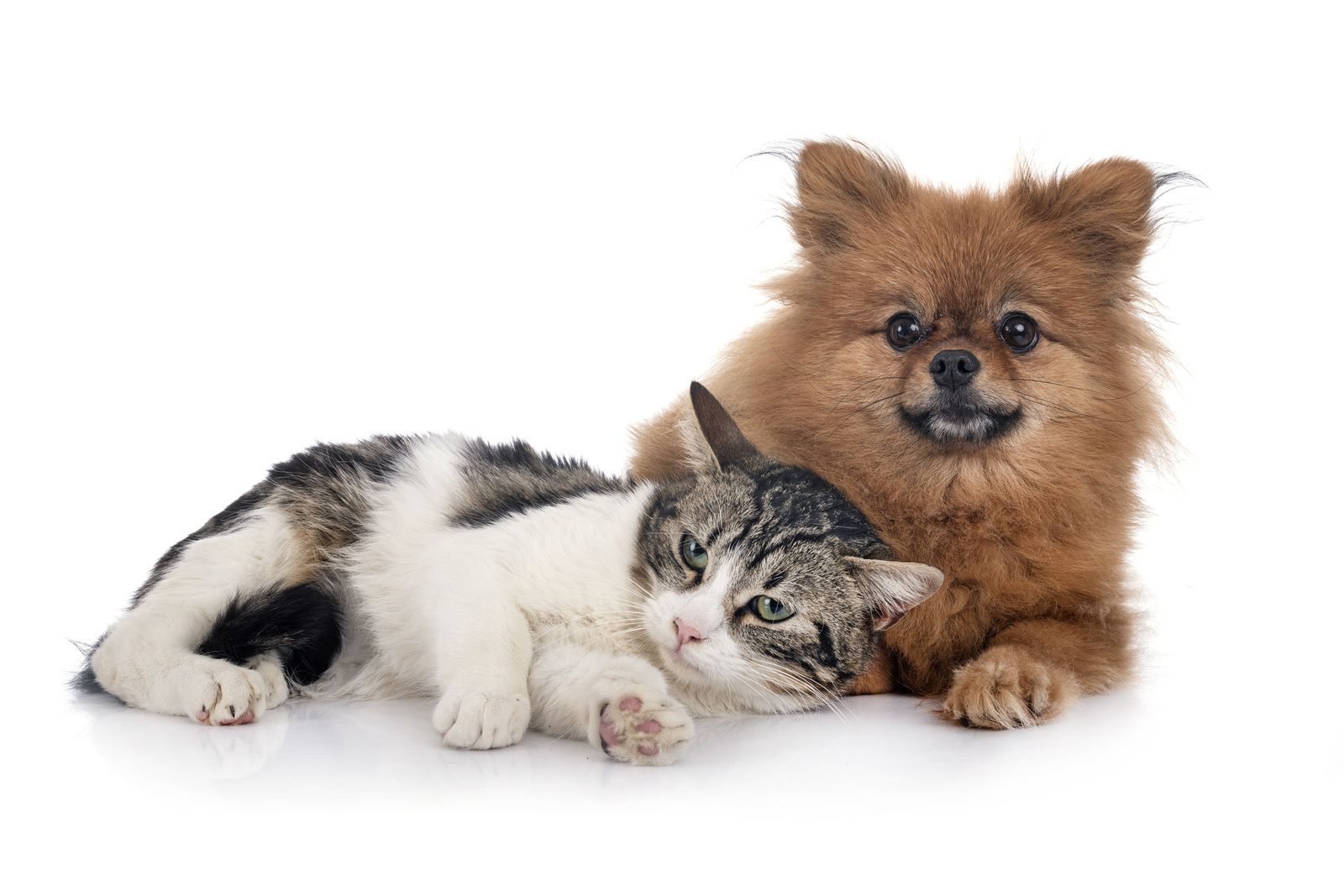
Gradual introductions for Pomeranians and Cats
- It’s wise to make any new introduction a slow, gradual process. Before the Pomeranian and Cat meet face to face for the first time, they can be made aware of the other’s existence. Here are a few tips to help you.
- The established homeowner must cordon off a specific room where his dog will be kept until being introduced. Although the pet is confined, ensure he doesn’t think he’s being punished. If possible, have a family member keep him company and give him some treats and/or a couple of new toys to play with (and keep him distracted).
- Once that’s achieved, bring them in and give him a guided tour of your home, ensuring he visits your dog’s sleep and play areas where his scents are the strongest. Then, let your dog come out and let him smell the cat scents left as he wandered around.
- After you finish this process and keep your dog on his leash for better control, bring them close together so they can meet. Ensure the cat can get away if necessary. Cats despise getting cornered, so if your dog spooks him, he can jump free or climb up his post to his safe spot.
Naturally, you would love it if both animals became friends from day one. However, this often doesn’t occur. If they show interest, that’s good; if they’re indifferent, that’s okay.
If both animals pretend the other doesn’t exist, that’s positive, which means neither feels threatened. However, this might not be long-lasting, especially if they realize that both are staying in the same house for good. It’s essential that you watch them until they finally accept each other.
Tips to Help Felines and Canines Become Friends
It will be approximately 2 – 3 weeks before you’ll really know if your pets are friendly towards each other. Follow these tips, and you can help speed things up.
Don’t force your pets to mingle. They’ll find their own way of doing things and need that freedom. If you make them stay in one room so they can make friends faster, it’s the quickest way to increase stress.
Create a separate space for each pet. They may want to spend lots of time together, even sleeping with each other. However, they also like a place for solitude and some “downtime” alone. This is vital if you don’t spend much time at home.
There will be plenty of time for the family and the pets to spend together, even lazily in front of the TV or chasing each other.
Dogs and cats eat different types of foods to suit their specific needs. Never allow your dog to eat your cat’s food. The food cats eat has more salt, a higher protein ratio, and differing fat amounts compared to dogs (although some dogs are tempted by cat food). A small amount of cat food won’t hurt your dog, but if he does this all the time, he may have stomach upsets, diarrhea, and other health problems.
Cats enjoy catnip for its stimulant effects. Don’t let your dog eat catnip because it may sedate him, cause water loss, cause diarrhea, and cause severe stomach aches.
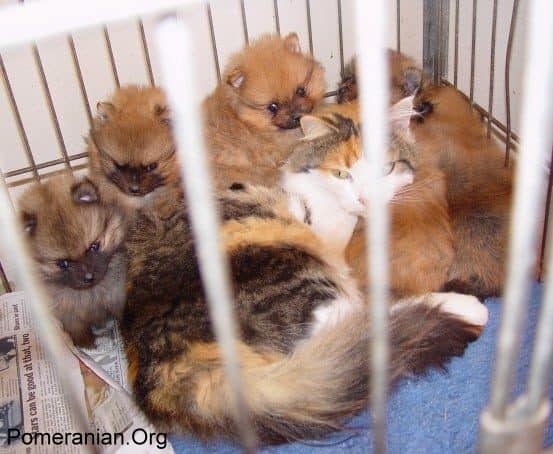
It’s best to have different eating times for your pets because, if they eat simultaneously, each may fear the other might eat his food, which can be highly stressful.
Keep your cat’s litterbox away from your dog where he can’t reach it, or he may eat cat feces. The top of the dryer or washing machine are handy spots.
As for sleeping arrangements, until you know for certain that they can tolerate each other, let your cat jump up to his bed, out of your dog’s grasp. Perhaps placing his scratching post in a high position will help him, too.
After week one, if your pets are getting along, try feeding both at once. Eating together helps form a bond and develops the concept that both belong to one pack (home). Put the cat’s food on a bench and prepare both bowls. Then, feed both simultaneously.
Praise your dog once he’s behaving around the cat. Even if you doubt he deserves praise, use it to make him aware that you’re happy about it, and he’ll behave most (or all) of the time, regardless of what he’s doing.
If Your Pomeranian and Cat Do Not Get Along
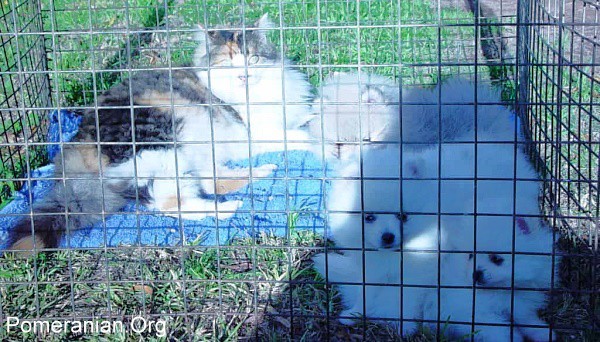
It’s serious if your pets don’t behave nicely after the first 2-3 weeks. If they fight and chase (but not for fun) or get hurt, it’s a massive warning signal that they won’t behave well together.
Most Pomeranians get on well with cats, but there are still some instances where it doesn’t happen. It’s best to keep them separate and, as a last resort, find one of them a good home.
Minor issues may happen. One animal commonly feels tired faster than the other, who still has lots of energy. If your two animals have a large age difference, the older one will grow tired because he won’t have that same tolerance for playing that a young animal possesses.
If your Pomeranian is annoying the cat often, or if they fight, you’ll need to command them by saying “NO!” Separate them and put both in a time-out situation. This can solve the problem for a while, but if it persists, you’ll learn what each pet will (or won’t) tolerate.
In this situation, always ensure your Pom and cat are never alone. Be aware that a cat’s sharp claws can easily cause major damage to a Pomeranian’s eyes.
If your cat keeps scratching your dog, you can buy a product with small, hollow plastic caps you place over each canine claw. They’re a bit like human nails that are glued on, and they prevent scratching. They’re considered humane and tolerable but not as sharp as real cat claws. You can do it at home, and one set (you can choose the color) lasts two months.

Final Thoughts on Does the Pomeranian and Cats Get Along?
In conclusion, integrating a Pomeranian puppy with a new cat in your home can lead to a rewarding companionship between your furry friends, despite the common misconception that small dogs and small animals cannot get along. When done correctly in a controlled environment, the introduction process plays a pivotal role in mitigating potential conflicts and ensuring the safety and happiness of both pets.
Providing separate spaces, such as separate rooms divided by a baby gate, allows each animal to have its own space, promoting a sense of security during the early stages of their relationship.
Positive reinforcement is crucial for encouraging good behavior, especially with toy breeds like Pomeranians, known for their high energy levels. Proper training regularly helps the new pet and cat understand expected behaviors, reduce signs of aggression, and ease the integration process.
Pet owners can foster a strong bond between their Pomeranian puppy and new cat by recognizing the importance of proper introductions and maintaining a patient, consistent approach.
Creating a home environment that respects both animals’ small size and unique needs, ensuring they each have their own retreat for peace and relaxation, is a good idea for long-term harmony. The best way to achieve the best results is by acknowledging the importance of their separate needs while encouraging their curiosity and safe interaction.
With time, your Pomeranian and cat can become best friends, disproving the myth that different species cannot coexist peacefully under one roof. Ultimately, the goal is a harmonious household where your Pomeranian and cat can thrive, supported by your thoughtful preparation and dedication to their well-being.
My answer to this is a big YES. After many years of owning Pomeranians and cats, I have found they quickly bond and become best buddies.
Copyright Pomeranian.Org. All Rights Reserved.
References and Further Reading:
[1] Denise Leo “The Pomeranian Handbook”.
Learn More About Pomeranian Dogs in My Book, The Pomeranian Handbook
